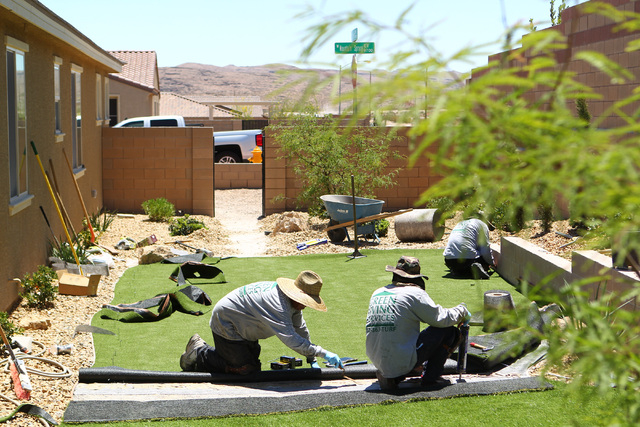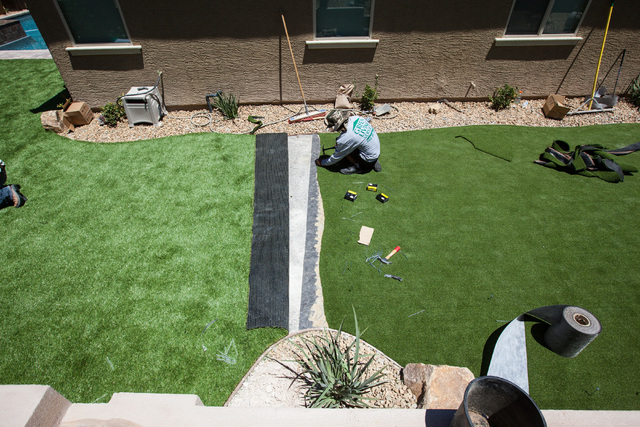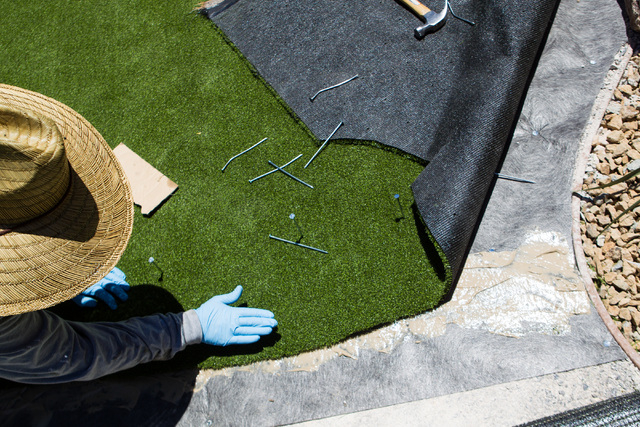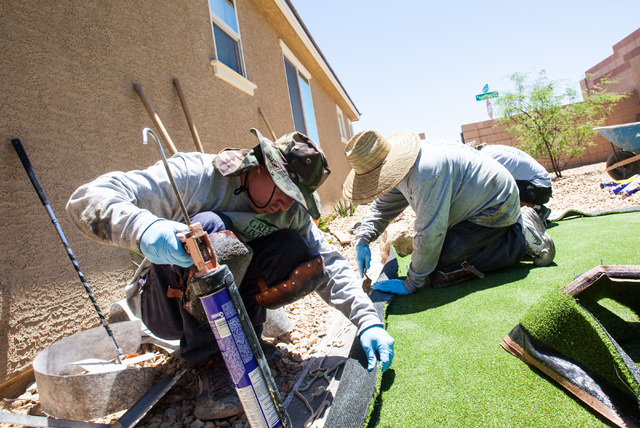Artificial turf takes root in Las Vegas yards, businesses
Blooming across the changing landscape of a new Las Vegas is a greenery of discarded tires.
Manufacturers and installers alike say artificial grass, made from recycled tire rubber, is growing more popular with each passing year as an option for residential yards, commercial landscapes and school athletic fields.
A multiyear drought and water restrictions, a recovering economy and desire to save on water bills has caused many customers to either convert to turf or start with it, they say.
Ken Foss, owner of Synthetic Lawns of Las Vegas, attributed the rising use to the drought as well as to the SNWA rebates. Between the refunds, an improving economy and a drop in water costs, people start spending more money.
His company averages about 40 installations per month, he said. July and August, usually slow months because of the Las Vegas heat, are already booked up. Foss is waiting to make sure that the increasing demand is real before adding more employees.
“If (demand) continues to climb, then yes, we’ll be looking for more help,” Foss said. “Not sure what we’ll get yet. We’re getting a lot more commercial (customers) and schools looking for it as well.”
Shannon Sweeney, operations manager for Synthetic Turf Products, a manufacturer, said the market for artificial grass in Las Vegas is “huge.” Hundreds of installation companies operate in the city, Sweeney said, including pool installation services and landscaping companies.
STF distributed product to at least 40 companies that employed more than 20 workers and had moved into a larger location and hired two new employees in the past three months, she said.
“Honestly, we’re busting at the seams,” Sweeney said.
Much of the demand has been driven by the Southern Nevada Water Authority’s Smart Landscapes rebate. Since 1999, the year the program was implemented, the water authority has given rebates for 48,481 single-family home projects that included conversions to at least some artificial grass, for an approximate total of 62.3 million square feet, said Hillery Francis, conservation programs coordinator at the authority. To qualify for the rebate, customers must apply some type of mulch to cover the ground, as well as low-flow drip irrigation and desert-friendly shade-plants. Artificial turf falls under the “mulch” category, Francis said.
Under the rebate program, authority customers who have natural grass lawns receive $1.50 for every square foot of natural grass that is removed and replaced with desert landscaping, up to the first 5,000 square feet. Beyond that first 5,000 feet, customers receive a $1 per square foot rebate. The rebate applies to one property per year.
NOT THE CHEAPEST OPTION
Of the conversion options, artificial turf is not the cheapest. At a minimum, it costs $6.50 per square foot, said Glenda Jorgenson, owner of landscaping company Dream Lawns. Another drawback is it absorbs heat from the desert sun, Jorgensen acknowledges, particularly at noon when the sun’s rays are beating down.
“You bet, it is hot,” Jorgensen says. “Once the sun goes indirect, when the sun isn’t directly overhead, it’s cooler. You can also hose it down. And then if you have any shade over it, it’s not an issue.”
Those drawbacks haven’t kept an increasing number of customers from opting for turf, particularly in recent years, Francis said. Between June 2011 and June 2012, 17 percent of customers who received the water authority rebate used artificial turf on their landscape. That figure increased each year through 2013-14, when 28 percent opted for turf.
After initial misgivings in the early 2000s, Las Vegas homeowner’s associations appear to be mostly on board with turf. Neither Francis nor any of the installers the Las Vegas Review-Journal spoke to recalled any objections from HOAs to homeowners installing turf in their neighborhoods. Meanwhile, turf is increasingly a popular option for HOA common areas because of its lack of maintenance requirements. Additionally, a 2009 law made it illegal for HOAs to prohibit the installation of turf.
Modern synthetic turf resembles spiky green carpet, consisting of a drainage layer and grasslike blades made of plastic strips woven into a “backing” layer. During installation, the turf is placed on a bed of crushed rock or compacted soil, along with adhesive strips, and stapled into place, like carpet. In order to make the artificial grass blades stand up and appear genuine, sand or rubber pellets are poured over the surface and mixed among the grass with a rake.
Rick Doyle, president of the Synthetic Turf Council, an industry group, said the sales projections his members were supplying him were increasing all the time.
“With the drought in California and Arizona and Southern Nevada, it wouldn’t surprise me if the market increased 20 or 30 percent,” Doyle said. “But demand is huge.”
HOTELS were EARLY customers
In Las Vegas, hotels were a major early adopter, Doyle said.
“Wynn (Las Vegas) was a big one, they were one of the first to go all synthetic, but I think (the hotels are) all synthetic now,” he said.
Wynn Las Vegas opened in 2005 with grounds manicured primarily with artificial turf, according to the STC website. Bellagio, The Venetian and Caesars Palace also now use turf.
Uses for the material include playgrounds, tennis courts, pet parks and even golf courses.
Still, don’t expect to see artificial turf overtaking the manicured fairways of golf courses anytime soon.
Chad Gunier, general manager at the Paiute Golf Resort, said he couldn’t think of any golf courses that used artificial turf, except at driving ranges to prevent divots. And he didn’t see it happening in the future, either.
“I don’t see it, just because that’s not what the customer wants,” Gunier said.
Contact Knowles Adkisson at kadkisson@reviewjournal.com or 702-224-5529. Find him on Twitter: @knowlesadkisson.



























